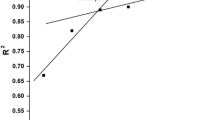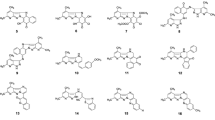Abstract
A QSAR model for antioxidative activity based on the Sub-Structural Molecular Design (TOPS-MODE) approach is developed for a series of compounds present in Brazilian propolis. This approach permitted the structural interpretation of the antioxidative activity of these compounds in terms of bond contributions. By these means we have identified the structural groups and regions that contribute to the antioxidative activity of the cinnamic acid and flavonoid derivatives present in the propolis. These results were then used to identify the positions and substituents to be used in a virtual compound generation experiment. Using this approach a total of 327 compounds were generated from which more than 70 are predicted to be more active than the most powerful antioxidants in the Brazilian propolis. From these 70 compounds less than 20 have been reported in the literature. Consequently, a high proportion of novel compounds with potential antioxidative activity has been identified by the current approach. This contributes to enhance the molecular diversity of the analogues of Brazilian propolis compounds with antioxidative properties.
Similar content being viewed by others
References
Scheller, S., Wilczok, T., Imielski, S., Krol, W., Gabrys, J. and Shani J., Free-radical scavenging by ethanol extract of propolis, Int. J. Radiat. Biol., 57 (1990) 461–465.
Volpert, R. and Elstner, E. F., Biochemical activities of propolis extracts. 1. Standardization and antioxidative properties of ethanolic and aqueous derivatives, Z. Naturforsch., 48 (1993) 851–857.
Rao, C. V., Desai, D., Kaul, B., Amin A. and Reddy, B. S., Effect of caffeic acid-esters on carcinogen-induced mutagenicity and human colon adenocarcinoma cell-growth, Chem. Biol. Interact., 84 (1992) 277–290.
Banskota, A. H., Tezuka, Y., Midorikawa, K., Matsushige, K. and Kadota, S., Two novel cytotoxic benzofuran derivatives from Brazilian propolis, J. Nat. Prod., 63 (2000) 1277–1279.
Marcucci, M. C., Propolis — Chemical-composition, biological properties and therapeutic activity, Apidologie, 26 (1995) 83–99.
Burdock, G. A., Review of the biological properties and toxicity of bee propolis (propolis), Food Chem. Toxicol., 36 (1998) 347–363.
Debiaggi, M., Tateo, F., Pagani, L., Luini, M. and Romero, E., Effects of propolis flavonoids on virus infectivity and replication, Microbiologica, 13 (1990) 207–213.
Dimov, V., Ivanovska, N., Bankova, V. and Popov, S., Immunomodulatory action of propolis. 4. Prophylactic activity against gram-negative infections and adjuvant effect of the water-soluble derivative, Vaccine, 10 (1992) 817–823.
Ghisalberti, E. L., Propolis — Review, Bee World, 60 (1979) 59–84.
Hayashi, K., Komura, S., Isaji, N., Ohisi, N. and Yagi, K., Isolation of antioxidative compounds from Brazilian propolis: 3,4-dihydroxy-5-prenylcinnamic acid, a novel potent antioxidant, Chem. Pharm. Bull., 47 (1999) 1521–1524.
Horie, T., Shibata, K., Yamashita, K., Kawamura, Y. and Tsukayami, M., Studies of the selective O-alkylation and dealkylation of flavonoids. A convenient method for synthesizing 3,5,7-trihydroxy-6-methoxyflavones, Chem. Pharm. Bull., 45 (1997) 446–451.
Aga, H., Shibuya, T., Sugimoto, T., Nakajima, S. and Kurimoto, M., Isolation and identification of Antimicrobial compounds in Brazilian Propolis, Biosci. Biotech. Biochem., 58 (1994) 945–946.
Fujimura, H., Sawada, T. and Kitagawa, I., 3-(4-Hydroxphenyl)-2-(E)-propenoic acid derivatives, Jpn. Kokai Tokkyo Koho, JP 60163841 Chem. Abstr., 104 (1985) 33867.
Okuno, I., Uchida, K., Sakurai, K. and Nakamura, M., Studies on choleretic constituents in Artemisia-Capillaris Thunb, Chem. Pharm. Bull., 36 (1988) 769–775.
Labbe, C., Rovirosa, J., Faini, F., Mahu., M., San-Martin, A. and Castillo, M., Secondary metabolites from Chilean Baccharis species, J. Na.t Prod., 49 (1986) 517–518.
Schmitt, A., Telikepali, H. and Mitscher, L. A., Plicatin-B, the antimicrobial principle of Psoralea-Juncea, Phytochemistry, 30 (1991), 3569–3570.
Shima, K., Hisada, S. and Inagaki, I., Studies on the constituents of Anodendron affine Durce. V. Isolation and structure of two new constituents, Yakugaku Zasshi, 92 (1972) 1410–1414.
Fuchino, H., Satoh, T., Tanaka, N., Chemical evaluation of Betula species in Japan. 3. Constituents of Betula maximowicziana, Chem. Pharm. Bull., 44 (1996) 1748–1753.
Kitagawa, I., Fukuda, Y., Yoshihara, M., Yamahara, J. and Yoshikawa, M., Capillartemisin A and B, two new choleretic principles from Artemisiae Capillaris Herba, Chem. Pharm. Bull., 31 (1983) 352–355.
Breton F. J. L., Gonzalez, G. A. and Ruiz S. O., Flavonoids of Centaurea arguta, An. R. Soc. Esp. Fis. Quim. Ser. B, 63 (1967) 703–710.
De Julian-Ortiz, J. V., Virtual Darwinian Drug Design: QSAR inverse problem, virtual combinatorial chemistry and computational screening, Comb. Chem. High Throughput Screen, 4 (2001) 295–310.
Gorse, D., Rees, A., Kaczorek, M. and Lahana, R., Molecular diversity and its analysis, Drug Discov. Today, 4 (1999) 257–264.
Oprea, T. I., Gottfries, J., Sherbukhin, V., Svensson, P. and Kuhler, T. C., Chemical information management in drug discovery: Optimising the computational and combinatorial chemistry, J. Mol. Graph. Model, 18 (2000) 512.
Gutierrez, Y. and Estrada, E., MODESLAB 1.0 (Molecular DEScriptors LABoratory) for Windows, Universidad de Santiago de Compostela, Spain, 2002.
Estrada, E., Peña, A. and García-Domenech, R., Designing sedative/hypnotic compounds from a novel substructural graph-theoretical approach, J. Comp.-Aided Mol. Des., 12 (1998) 583–595.
Estrada, E. and Peña, A., In silico studies for the rational discovery of anticonvulsant compounds, Bioorg. Med. Chem., 8 (2000) 2755–2770.
Estrada, E., Uriarte, E., Montero, A., Teijeira, M., Santana, L. and De Clercq, E., A novel approach for the virtual screening and rational design of anticancer compounds, J. Med. Chem., 43 (2000) 1975–1985.
Estrada, E., On the topological sub-structural molecular design (TOSS-MODE) in QSPR/QSAR and drug design research, SAR QSAR Environ. Res., 11 (2000) 55–73.
Estrada, E. and Uriarte, E., Quantitative structure-toxicity relationships using TOPS-MODE. 1. Nitrobenzene toxicity to tetrahymena pyriformis, SAR QSAR Environ. Res., 12 (2001) 309–324.
Estrada, E., Molina, E. and Uriarte, E., Quantitative structure-toxicity relationships using Tops-Mode. 2. Neurotoxicity of a non-congeneric series of solvents, SAR QSAR Environ. Res., 12 (2001) 445–459.
Estrada, E., Uriarte, E., Gutierrez, Y. and Gonzalez, H., Quantitative structure-toxicity relationships using TOPS-MODE. 3. Structural factors influencing the permeability of commercial solvents through living human skin, SAR QSAR Environ. Res., 14 (2003) 145–163.
Estrada, E., Spectral moments of the edge adjacency matrix in molecular graphs. 1. Definition and applications to the prediction of physical properties of alkanes, J. Chem. Inf. Comput. Sci., 36 (1996) 844–849.
Estrada, E., Spectral moments of the edge adjacency matrix of molecular graphs. 2. Molecules containing heteroatoms and QSAR applications, J. Chem. Inf. Comput. Sci., 37 (1997) 320–328.
Estrada, E., Spectral moments of the edge adjacency matrix of molecular graphs. 3. Molecules containing cycles, J. Chem. Inf. Comput. Sci., 38 (1998) 23–27.
Wang, R., Gao, Y. and Lai, L., Calculating partition coefficient by atom-additive method, Persp. Drug Discov. Des., 19 (2000) 47–66.
Ertl, P., Rohde, B. and Selzer, P., Fast calculation of molecular polar surface area as a sum of fragment-based contributions and its application to the prediction of drug transport properties, J. Med. Chem., 43 (2000) 3714–3717.
Miller, K. J., Additivity methods in molecular polarizability, J. Am. Chem. Soc., 112 (1990) 8533–8542.
Gasteiger, J. and Marsilli, M., A new model for calculating atomic charges in molcules, Tetrahedron. Lett., 34 (1978) 3181–3184.
Bondi, A., van der Waals volumes and radii, J. Phys Chem, 68 (1964) 441–451.
Ghose, A. K. and Crippen, G. M., Atomic physicochemical parameters for three-dimensional-structure-directed quantitative structure-activity relationships. 2. Modeling dispersive and hydrophobic interactions, J. Chem. Inf. Comput. Sci., 27 (1987) 21–35.
Estrada, E., Edge adjacency relationships and a novel topological index related to molecular volume, J. Chem. Inf. Comput. Sci, 35 (1995) 31–33.
Estrada, E. and Molina, E., Novel local (fragment-based) topological molecular descriptors for QSPR/QSAR and molecular design, J. Mol. Graph. Modell., 20 (2001) 54–64.
Estrada, E. and Molina, E., 'QSPR/QSAR by Graph Theoretical Descriptors beyond the Frontiers', in M. Diudea (ed.), QSPR/QSAR Studies by Molecular Descriptors, Nova Sci., New York, 2001, pp. 83–107.
Hotta, H., Sakamoto, H., Nagano, S., Osakai, T. and Tsujino, Y., Unusually large numbers of electrons for the oxidation of polyphenolic antioxidants, Biochim. Biophys. Acta, 1526 (2001) 159–167.
Hotta, H., Nagano, S., Ueda, M., Tsujino, Y., Koyama, J. and Osakai, T., Higher radical scavenging activities of polyphenolic antioxidants can be ascribed to chemical reactions following their oxidation, Biochim. Biophys. Acta, 1572 (2002) 123–132.
Surh, Y.-J., Molecular mechanisms of chemopreventive effects of selected dietary and medicinal phenolic substances, Mut. Res., 428 (1999) 305–327.
Bors, W., Michel C., Stettmaier, K., Lu, Y. and Yeap Foo, L., Pulse radiolysis, electron paramagnetic resonance spectroscopy and theoretical calculations of caffeic acid oligomer radicals, Biochim. Biophys. Acta, 1620 (2003) 97–107.
Moon, J.-H. and Terao, J., Antioxidant activity of caffeic acid and dihydrocaffeic acid in lard and human low-density lioprotein, J. Agric. Food Chem., 46 (1998) 5062–6065.
Silva, F. A. M., Borges, F., Guimarães, C., José, L. F. C., Lima, Matos, C. and Reis, S., Phenolic acids and derivatives: Studies on the relationship among structure, radical scavenging activity and physicochemical parameters, J. Agric. Food Chem., 48 (2000) 2122–2126.
Raneva, V., Shimasaki, H., Ishida, Y., Ueta, N. and Niki, E., Antioxidant activity of 3,4-dihydroxyphenylacetic acid and caffeic acid in rat plasma, Lipids, 36 (2001) 1111–1116.
Bankova, V. S., Popov, S.S., Marekov, N.L., A study on flavonoids of propolis, J. Nat. Prod., 46 (1983) 471–474.
Saija, A., Trombetta, D., Tomaino, A., Lo Cascio, R., Princi, P., Uccella, N., Bonina, F. and Castelli, F., 'In vitro' evaluation of the antioxidant activity and biomembrane interaction of the plant phenols oleuropein and hydroxytyrosol, Int. J. Pharm., 166 (1998) 123–133.
Author information
Authors and Affiliations
Corresponding author
Rights and permissions
About this article
Cite this article
Estrada, E., Quincoces, J.A. & Patlewicz, G. Creating molecular diversity from antioxidants in Brazilian propolis. Combination of TOPS-MODE QSAR and virtual structure generation. Mol Divers 8, 21–33 (2004). https://doi.org/10.1023/B:MODI.0000006804.97390.40
Issue Date:
DOI: https://doi.org/10.1023/B:MODI.0000006804.97390.40




